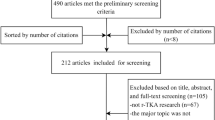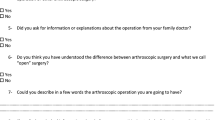Abstract
Background
The internet is increasingly being used as a resource for health-related information by the general public. We sought to establish the authorship, content and accuracy of the information available online regarding computer-assisted total knee arthroplasty (CA-TKA).
Methods
One hundred fifty search results from three leading search engines available online (Google, Yahoo!, Bing) from ten different countries worldwide were reviewed.
Results
While private physicians/groups authored 50.7 % of the websites, only 17.3 % were authored by a hospital/university. As compared to traditional TKA, 59.3 % of the websites claimed that navigated TKA offers better longevity, 46.6 % claimed accelerated recovery and 26 % claimed fewer complications. Only 11.3 % mentioned the prolonged operating room time required, and only 15.3 % noted the current lack of long-term evidence in support of this technology.
Conclusions
Patients seeking information regarding CA-TKA through the major search engines are likely to encounter websites presenting a narrow, unscientific, viewpoint of the present technology, putting emphasis on unsubstantiated benefits while disregarding potential drawbacks.
Level of evidence
Survey of Materials—Internet.

Similar content being viewed by others
References
Bäthis H, Perlick L, Tingart M, Lüring C, Zurakowski D, Grifka J (2004) Alignment in total knee arthroplasty a comparison of computer-assisted surgery with the conventional technique. J Bone Joint Surg Br 86:682–687
Bolognesi M, Hofmann A (2005) Computer navigation versus standard instrumentation for TKA: a single-surgeon experience. Clin Orthop Relat Res 440:162–169
Ensini A, Catani F, Leardini A, Romagnoli M, Giannini S (2007) Alignments and clinical results in conventional and navigated total knee arthroplasty. Clin Orthop Relat Res 457:156–162
Haaker RG, Stockheim M, Kamp M, Proff G, Breitenfelder J, Ottersbach A (2005) Computer-assisted navigation increases precision of component placement in total knee arthroplasty. Clin Orthop Relat Res 433:152–159
Kim SJ, MacDonald M, Hernandez J, Wixson RL (2005) Computer assisted navigation in total knee arthroplasty: improved coronal alignment. J Arthroplast 20:123–131
Matziolis G, Krocker D, Weiss U, Tohtz S, Perka C (2007) A prospective, randomized study of computer-assisted and conventional total knee arthroplasty. J Bone Joint Surg 89:236–243
Burnett RSJ, Barrack RL (2013) Computer-assisted total knee arthroplasty is currently of no proven clinical benefit: a systematic review. Clin Orthop Relat Res 471:264–276
Bauwens K, Matthes G, Wich M, Gebhard F, Hanson B, Ekkernkamp A, Stengel D (2007) Navigated total knee replacement. J Bone Joint Surg 89:261–269
Cheng T, Zhang G, Zhang X (2010) Clinical and radiographic outcomes of image-based computer-assisted total knee arthroplasty: an evidence-based evaluation. Surg Innov. doi:10.1177/1553350610382012
Cip J, Widemschek M, Luegmair M, Sheinkop MB, Benesch T, Martin A (2014) Conventional versus computer-assisted technique for total knee arthroplasty: a minimum of 5-year follow-up of 200 patients in a prospective randomized comparative trial. J Arthroplast 29:1795–1802
Harvie P, Sloan K, Beaver RJ (2012) Computer navigation vs conventional total knee arthroplasty: five-year functional results of a prospective randomized trial. J Arthroplast 27:667–672.e661
Scarlat MM, Mavrogenis AF, Pecina M, Niculescu M (2015) Impact and alternative metrics for medical publishing: our experience with International Orthopaedics. Int Orthop 39:1459–1464. doi:10.1007/s00264-015-2766-y
Fox S (2011) Health Topics. Pew Internet and American Life Project
Kurup V, Considine A, Hersey D, Dai F, Senior A, Silverman D, Dabu-Bondoc S (2013) Role of the Internet as an information resource for surgical patients: a survey of 877 patients. Br J Anaesth 110:54–58
Hendrick PA, Ahmed OH, Bankier SS, Chan TJ, Crawford SA, Ryder CR, Welsh LJ, Schneiders AG (2012) Acute low back pain information online: an evaluation of quality, content accuracy and readability of related websites. Man Ther 17:318–324
de Boer MJ, Versteegen GJ, van Wijhe M (2007) Patients’ use of the Internet for pain-related medical information. Patient Educ Couns 68:86–97
AlGhamdi KM, Moussa NA (2012) Internet use by the public to search for health-related information. Int J Med Inform 81:363–373
Metzger MJ (2007) Making sense of credibility on the Web: models for evaluating online information and recommendations for future research. J Am Soc Inf Sci Technol 58:2078–2091
Cline RJ, Haynes KM (2001) Consumer health information seeking on the Internet: the state of the art. Health Educ Res 16:671–692
Rose S, Bruce J, Maffulli N (1998) Accessing the Internet for patient information about orthopedics. JAMA 280:1309
Mohan R, Paul HY, Hansen EN (2015) Evaluating online information regarding the direct anterior approach for total hip arthroplasty. J Arthroplast 30:803–807
Labovitch RS, Bozic KJ, Hansen E (2006) An evaluation of information available on the internet regarding minimally invasive hip arthroplasty. J Arthroplast 21:1–5
Koller U, Waldstein W, Schatz KD, Windhager R (2016) YouTube provides irrelevant information for the diagnosis and treatment of hip arthritis. Int Orthop. doi:10.1007/s00264-016-3174-7
Westerwick A (2013) Effects of sponsorship, web site design, and Google ranking on the credibility of online information. J Comput-Mediat Commun 18:80–97
Netmarketshare.com. Search engine market share
Bonutti P, Dethmers D, Stiehl JB (2008) Case report. Clin Orthop Relat Res 466:1499–1502
Bonutti PM, Dethmers D, Ulrich SD, Seyler TM, Mont MA (2008) Computer navigation-assisted versus minimally invasive TKA. Clin Orthop Relat Res 466:2756–2762
Bonutti PM, Dethmers DA, McGrath MS, Ulrich SD, Mont MA (2008) Navigation did not improve the precision of minimally invasive knee arthroplasty. Clin Orthop Relat Res 466:2730–2735
Kim Y-H, Kim J-S, Choi Y, Kwon O-R (2009) Computer-assisted surgical navigation does not improve the alignment and orientation of the components in total knee arthroplasty. J Bone Joint Surg 91:14–19
Kim Y-H, Kim J-S, Yoon S-H (2007) Alignment and orientation of the components in total knee replacement with and without navigation support: a prospective, randomised study. J Bone Joint Surg Br 89:471–476
Lützner J, Krummenauer F, Wolf C, Günther K-P, Kirschner S (2008) Computer-assisted and conventional total knee replacement a comparative, prospective, randomised study with radiological and ct evaluation. J Bone Joint Surg Br 90:1039–1044
Stulberg SD, Yaffe MA, Koo SS (2006) Computer-assisted surgery versus manual total knee arthroplasty: a case-controlled study. J Bone Joint Surg 88:47–54
Roberts TD, Clatworthy MG, Frampton CM, Young SW (2015) Does computer assisted navigation improve functional outcomes and implant survivability after total knee arthroplasty? J Arthroplast 30:59–63
De Steiger RN, Liu Y-L, Graves SE (2015) Computer navigation for total knee arthroplasty reduces revision rate for patients less than sixty-five years of age. J Bone Joint Surg 97:635–642
Gøthesen Ø, Espehaug B, Havelin L, Petursson G, Furnes O (2011) Short-term outcome of 1,465 computer-navigated primary total knee replacements 2005–2008: a report from the Norwegian Arthroplasty Register. Acta Orthop 82:293–300
Aoude A, Aldebeyan S, Nooh A, Weber MH, Tanzer M (2016) Thirty day complications of conventional and computer-assisted total knee and total hip arthroplasty: analysis of 103,855 patients in ACS-NSQIP database. J Arthroplast doi.org/10.1016/j.arth.2016.01.042
Kalairajah Y, Cossey A, Verrall G, Ludbrook G, Spriggins A (2006) Are systemic emboli reduced in computer-assisted knee surgery? A prospective, randomised, clinical trial. J Bone Joint Surg Br 88:198–202
Church JS, Scadden JE, Gupta RR, Cokis C, Williams KA, Janes GC (2007) Embolic phenomena during computer-assisted and conventional total knee replacement. J Bone Joint Surg (Br) 89:481–485. doi:10.1302/0301-620X.89B4.18470
Peersman G, Laskin R, Davis J, Peterson M, Richart T (2006) Prolonged operative time correlates with increased infection rate after total knee arthroplasty. HSS J 2:70–72
Prasad N, Padmanabhan V, Mullaji A (2007) Blood loss in total knee arthroplasty: an analysis of risk factors. Int Orthop 31:39–44
Lawrentschuk N, Abouassaly R, Hackett N, Groll R, Fleshner NE (2009) Health information quality on the internet in urological oncology: a multilingual longitudinal evaluation. Urology 74:1058–1063
Eastin MS (2001) Credibility assessments of online health information: the effects of source expertise and knowledge of content. J Comput-Mediat Commun 6
Pour AE, Bradbury TL, Horst P, Harrast JJ, Erens GA, Roberson JR (2016) Trends in primary and revision knee arthroplasty among orthopaedic surgeons who take the American Board of Orthopaedics part II exam. Int Orthop. doi:10.1007/s00264-016-3137-z
Author contributions statement
All authors have demonstrated [1] substantial contributions to research design, or the acquisition, analysis or interpretation of data; [2] drafting the paper or revising it critically; [3] approval of the submitted and final versions.
Author information
Authors and Affiliations
Corresponding author
Rights and permissions
About this article
Cite this article
Shemesh, S.S., Bronson, M.J. & Moucha, C.S. Computer-assisted total knee arthroplasty marketing and patient education: an evaluation of quality, content and accuracy of related websites. International Orthopaedics (SICOT) 40, 2003–2009 (2016). https://doi.org/10.1007/s00264-016-3215-2
Received:
Accepted:
Published:
Issue Date:
DOI: https://doi.org/10.1007/s00264-016-3215-2




